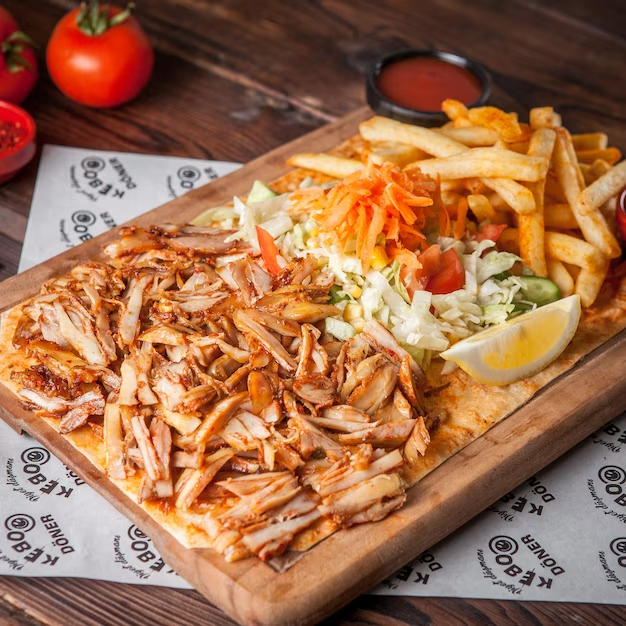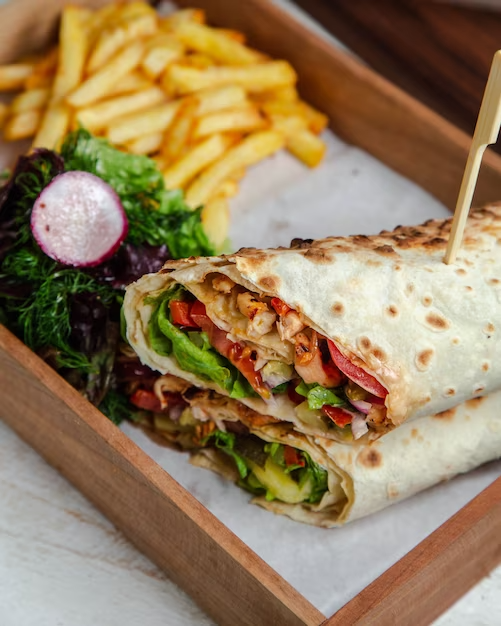shawarma ( Doner Kebab ) of Turkish Cuisine, red meat or white meat is thinned and marinated with different tastes and flavoring substances at certain rates,
then it is cooked by arranging it tightly in a tubular metal bottle, turning it in a vertically positioned cooker and cooking the cooked parts for about 3 minutes with the help of a long sharp knife. It is defined as the product obtained after cutting at a thickness of -5 mm.
Culture in order to ensure that doner kebab, which has an important role in the promotion of Turkish culinary culture, is a preferred dish both in the fast food sector and in restaurant menus.

Table of Contents
Definition and History of shawarma of Turkish Cuisine
After marinating doner, leaf, or minced meat (e.g. beef, veal, sheep, lamb, goat) and poultry (e.g. chicken, turkey) with various additives and seasonings for 3-12 hours, the meats are tightly pressed onto the doner kebab skewer. It is defined as a meat dish obtained by shaving by laying a layer of internal fat in between and cooking in a vertically positioned stove (TS, 2003: Acar, 1996: Kupeli, 1996; Todd et al., 1986).
It is reported that doner kebab first emerged 150 years ago in Bursa by Iskender Bey, by passing lamb meat through a bottle and cooking it in a vertically positioned wood stove (Acar, 1996). Also Yaman (1993), the doner kebab was first cooked in Kastamonu, after the lamb was rested with various spices for one night, then it was cooked in a long bottle and turned in front of a vertical wood stove.
TURKISH CUISINE’S DONER KEBAB Features:
The general characteristics of doner kebab ( shawarma ) are examined in 3 groups as physical-sensory, chemical, and microbiological properties. According to TSE (2003),
the sensory properties of doner are shown in Table 1

In addition to the physical-sensory properties of shawarma, its chemical properties are of great importance in terms of quality. The chemical properties of doner kebab are given in Table 2 (TSE, 2003).

TURKISH CUISINE’S DONER KEBAB Production:
Doner kebab production; raw material supply, marinating the meat with various marinades, attaching the meat to the shawarma, and shaving, cooking, and serving stages (TSE, 2003). Red and poultry meats to be used in the preparation of doner kebab should be obtained hygienically by using appropriate cutting methods. shawarma is produced from red meat, veal, beef or lamb carcasses from parts such as thighs (eg, trance, egg, loin) and back (eg, entrecote, contrafile); On the other hand, shawarma are prepared from chicken and turkey meats are prepared using the meat of the breast and fillet regions of the carcass (TSE, 2003). For shawarma, which will be prepared in the form of minced meat, the meat should be minced by attaching the 0-1 chuck of the meat grinder. In doner kebabs, which will be prepared in the form of leaf composition, the meat is divided into 3-8 mm thick leaf-shaped pieces (TSE, 2003; TSE, 1995). Marinating is called a 3-12 hour aging process by adding various spices and seasoning substances (eg onion, salt, oil) to red and poultry meats at a certain rate. In marinating, it is aimed to make the meat soft and crispy, thus adding flavor and aroma.
Spices used in the marination of shawarma; red pepper (Capsicum annum), black pepper (Piper nigrum), cumin (Cuminum cymnum), allspice (Pimenta officinalis), thyme (Thymus vulgaris), salt (NaCl) (TSE, 1995). In addition to the spices mentioned above; onion juice, garlic, milk, yogurt, tomato paste, oil, tomato juice or paste, lemon juice, milk powder, vinegar, yogurt, egg, and grape must also be used (TSE, 1995; Jöckel and Stengel, 1984; Krüger et al 1993). ; Acar 1996; Üzümcüoğlu 2001). There are differences according to the type of raw material (eg, red meat, poultry) to be used in the production of shawarma during the marination stage and according to the enterprises that are the doner kebab producers (Jöckel and Stengel, 1984; Krüger et al., 1993).
Red and winged meats should be put on theshawarma after marinating. First of all, a mirror is attached to the shawarma and must be fixed. Meats should be placed on the shawarma skewer from the bottom to the top, by arranging leaves in the form of oil between them. The bottle arranging process should be adjusted so that the oil reaches the top. Meat is prepared in 3 different ways, as cut egg, cut shuttle or cut conical, by shaving the pieces left over from the sides after the bottle is attached (TSE, 1995: TSE, 2003).
shawarma production; raw material supply, marinating the meat with various marinades, attaching the meat to the shawarma, and shaving, cooking, and serving stages (TSE, 2003). Red and poultry meats to be used in the preparation of doner kebab should be obtained hygienically by using appropriate cutting methods.
shawarma is produced from red meat, veal, beef or lamb carcasses from parts such as thighs (eg, trance, egg, loin) and back (eg, entrecote, contrafile); On the other hand, doner kebabs are prepared from chicken and turkey meats are prepared using the meat of the breast and fillet regions of the carcass (TSE, 2003). For doner kebab, which will be prepared in the form of minced meat, the meat should be minced by attaching the 0-1 chuck of the meat grinder. In doner kebabs, which will be prepared in the form of leaf composition, the meat is divided into 3-8 mm thick leaf-shaped pieces (TSE, 2003; TSE, 1995). Marinating is called a 3-12 hour aging process by adding various spices and seasoning substances (eg onion, salt, oil) to red and poultry meats at a certain rate. In marinating, it is aimed to make the meat soft and crispy, thus adding flavor and aroma.
Spices used in the marination of doner kebab; red pepper (Capsicum annum), black pepper (Piper nigrum), cumin (Cuminum cymnum), allspice (Pimenta officinalis), thyme (Thymus vulgaris), salt (NaCl) (TSE, 1995). In addition to the spices mentioned above; onion juice, garlic, milk, yogurt, tomato paste, oil, tomato juice or paste, lemon juice, milk powder, vinegar, yogurt, egg, and grape must also be used (TSE, 1995; Jöckel and Stengel, 1984; Krüger et al 1993). ; Acar 1996; Üzümcüoğlu 2001). There are differences according to the type of raw material (eg, red meat, poultry) to be used in the production of doner kebab during the marination stage and according to the enterprises that are the doner kebab producers (Jöckel and Stengel, 1984; Krüger et al., 1993).
Red and winged meats should be put on the doner kebab after marinating. First of all, a mirror is attached to the doner skewer and must be fixed. Meats should be placed on the doner kebab skewer from the bottom to the top, by arranging leaves in the form of oil between them. The bottle arranging process should be adjusted so that the oil reaches the top. Meat is prepared in 3 different ways, as cut egg, cut shuttle or cut conical, by shaving the pieces left over from the sides after the bottle is attached (TSE, 1995: TSE, 2003).

The cooking phase of the doner kebab is as important as the preparation phase. Doner kebabs are cooked sufficiently by turning them in the above-mentioned vertically positioned stoves and the cooked parts are cut with the help of the doner knife (TSE, 2003). The preparation of doner kebab in large diameters and weights has a great influence on the temperature values of the interior.
It has been reported that the temperature inside the doner kebab can reach suitable values (5-25 °C) for the growth of psychrotrophic and mesophilic microorganisms due to the long time (approximately 8-10 hours) waiting for the doner kebab in front of the stove (Jöckel and Stengel, 1984: Acar, 1996). Jöckel and Stengel (1984) and Todd et al.
(1986) stated that the internal temperature values of doner kebabs vary between 2.3 °C and 42.4 °C according to the diameter length. Similarly, Acar (1996) stated that the outside temperature of the doner kebabs prepared from red meat is 38-55°C and the internal temperature is 8-30°C; It is reported that the outside temperature varies between 32.5-46 °C and the internal temperature varies between 12.4-30 °C in the lower parts. In cases where the cooking process is not done effectively and adequately, inside the doner kebab
It has been reported that the microorganisms found cannot be destroyed, thus causing food poisoning (Acar 1996; Kupeli 1996; Ayaz et al., 1985: Jöckel and Stengel, 1984). Doner kebab is consumed in various forms such as plain, iskender, and bread after it is cooked and cut (Jöckel and Stengel 1984; Krüger et al 1993)
Doner Kebab of Turkish Cuisine Arrangement and Trimming of Meat on Doner Skewers:
Red and winged meats are put on the doner kebab after
marinating. First, a mirror is attached to the doner skewer and fixed. The meats are placed on the doner kebab skewer from the bottom to the top, by arranging leaves in the form of oil between them. Bottle arranging is arranged so that the oil reaches the top.
Meat is prepared in 3 different ways: cut eggs, cut shuttle or cut conical pieces by shaving the pieces left over from the sides after the bottle is attached (TSE 1995; TSE 2003).
Cooking Doner Kebab:

The preparation stage of doner kebab is as important as the cooking stage. Doner kebabs are cooked adequately by turning them on the above-mentioned vertically positioned stoves. Doner parts cut with doner knife should be served in a short time without waiting (Stolle et al., 1993).
For more information on obtaining delicious DÖNER KEBAP with international specifications, contact NanoPro for Food and Industrial Consultin

